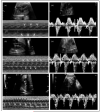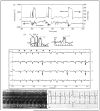Overview of fetal arrhythmias
- PMID: 18781114
- PMCID: PMC3326657
- DOI: 10.1097/MOP.0b013e32830f93ec
Overview of fetal arrhythmias
Abstract
Purpose of review: Though fetal arrhythmias account for a small proportion of referrals to a fetal cardiologist, they may be associated with significant morbidity and mortality. The present review outlines the current literature with regard to the diagnosis and, in brief, some management strategies in fetal arrhythmias.
Recent findings: Advances in echocardiography have resulted in significant improvements in our ability to elucidate the mechanism of arrhythmia at the bedside. At the same time, magnetocardiography is broadening our understanding of mechanisms of arrhythmia especially as it pertains to ventricular arrhythmias and congenital heart block. It provides a unique window to study electrical properties of the fetal heart, unlike what has been available to date. Recent reports of bedside use of fetal ECG make it a promising new technology. Fetal magnetocardiography is also developing. The underlying mechanisms resulting in immune-mediated complete heart block in a small subset of 'at-risk' fetuses is under investigation.
Summary: There have been great strides in noninvasive diagnosis of fetal arrhythmias. However, we still need to improve our knowledge of the electromechanical properties of the fetal heart as well as the mechanisms of arrhythmia to further improve outcomes. Multiinstitutional collaborative studies are needed to help answer some of the questions regarding patient, drug selection and management algorithms.
Figures




Similar articles
-
[Application of fetal echocardiography in detection of fetal arrhythmia and its clinical significance].Zhonghua Fu Chan Ke Za Zhi. 2004 Jun;39(6):365-8. Zhonghua Fu Chan Ke Za Zhi. 2004. PMID: 15312317 Chinese.
-
[Fetal arrhythmias].Duodecim. 2014;130(2):152-60. Duodecim. 2014. PMID: 24605430 Review. Finnish.
-
The Incremental Benefit of Color Tissue Doppler in Fetal Arrhythmia Assessment.J Am Soc Echocardiogr. 2019 Jan;32(1):145-156. doi: 10.1016/j.echo.2018.08.009. Epub 2018 Oct 16. J Am Soc Echocardiogr. 2019. PMID: 30340890
-
Fetal echocardiography: a review of 1,028 consecutive examinations.J S C Med Assoc. 1995 Aug;91(8):333-7. J S C Med Assoc. 1995. PMID: 7674633 No abstract available.
-
Fetal cardiac arrhythmia detection and in utero therapy.Nat Rev Cardiol. 2010 May;7(5):277-90. doi: 10.1038/nrcardio.2010.32. Nat Rev Cardiol. 2010. PMID: 20418904 Free PMC article. Review.
Cited by
-
Postnatal outcome in patients with fetal tachycardia.Pediatr Cardiol. 2013 Jan;34(1):81-7. doi: 10.1007/s00246-012-0392-7. Epub 2012 May 26. Pediatr Cardiol. 2013. PMID: 22639009
-
Influence of pemphigoid gestationis on pregnancy outcome: A case report and review of the literature.Exp Ther Med. 2022 Jan;23(1):23. doi: 10.3892/etm.2021.10945. Epub 2021 Nov 4. Exp Ther Med. 2022. PMID: 34815775 Free PMC article.
-
Prenatal diagnosis of fetal bradyarrhythmia and postnatal outcome.Indian Pacing Electrophysiol J. 2024 Jan-Feb;24(1):20-24. doi: 10.1016/j.ipej.2023.10.003. Epub 2023 Oct 13. Indian Pacing Electrophysiol J. 2024. PMID: 37838306 Free PMC article.
-
Importance of Fetal Arrhythmias to the Neonatologist and Pediatrician.Neoreviews. 2016 Oct;17(10):e568-e578. doi: 10.1542/neo.17-10-e568. Neoreviews. 2016. PMID: 28042286 Free PMC article.
-
Pulse-driven magnetoimpedance sensor detection of cardiac magnetic activity.PLoS One. 2011;6(10):e25834. doi: 10.1371/journal.pone.0025834. Epub 2011 Oct 12. PLoS One. 2011. PMID: 22022453 Free PMC article.
References
-
-
Hornberger LK. Echocardiographic assessment of fetal arrhythmias. Heart. 2007;93:1331–1333. This article is a nice review of current echocardiographic techniques for the evaluation of fetal arrhythmias.
-
-
- Dancea A, Fouron JC, Miro J, et al. Correlation between electrocardiographic and ultrasonographic time-interval measurements in fetal lamb heart. Pediatr Res. 2000;47:324–328. - PubMed
-
- Rosenthal D, Friedman DM, Buyon J, et al. Validation of the Doppler PR interval in the fetus. J Am Soc Echocardiogr. 2002;15:1029–1030. - PubMed
Publication types
MeSH terms
Grants and funding
LinkOut - more resources
Full Text Sources
Medical
Research Materials

